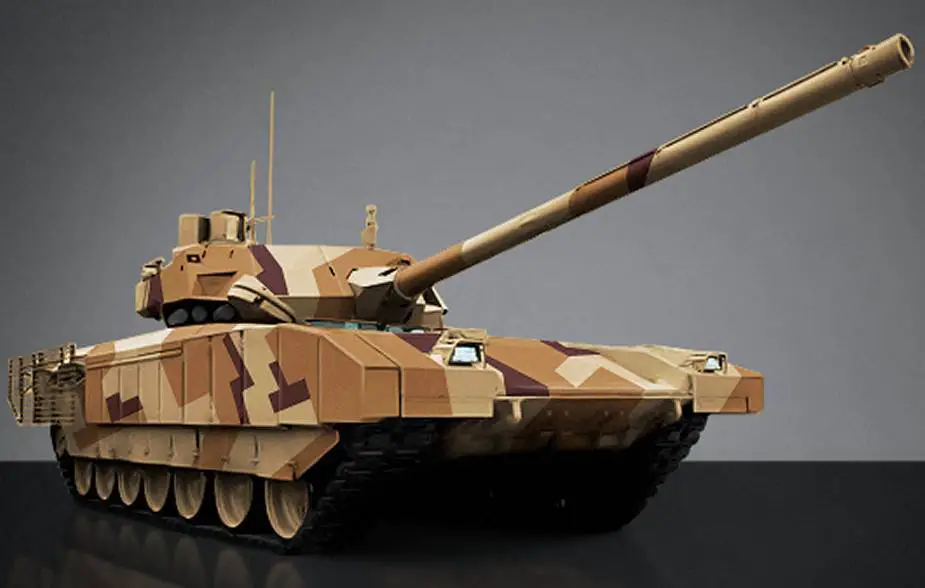Breaking news
IDEX 2021: 6 countries express desire to buy Russian T-14 Armata tank.
Rostec announced in a press release on February 24 at IDEX 2021 that six countries are interested in buying its T-14 Armata tank, without providing any additional information. T-14 Armata was created specifically for so-called network-centric warfare. That is, the T-14 does not fight alone, but as part of a tactical group that is within a unified control system at all times. The group may include heavy infantry fighting vehicles, self-propelled guns, T-90 tanks, and attack helicopters. T-14 is assigned the role of a scout, target designator, and fire spotter in this chain. The tank is distinguished by a high degree of automation.

At IDEX 2021, Rostec is showcasing a mockup of its T-14 Aramata tank to mark the launch of the international commercialization of this 3rd generation tank (Picture source: Rostec)
The main armament of the T-14 Armata is the 2A82-1M 125 mm (4.92 in) smoothbore cannon, a replacement for the 2A46 125 mm gun of previous Russian and Soviet tanks. According to Russian sources, its muzzle energy is greater than that of the German Leopard 2's Rheinmetall 120 mm gun, features include an absence of a fume extractor (due to the unmanned turret), a fire rate of 10–12 rpm (rounds per minute), left side casing ejection port for the 125 mm gun and a maximum effective-penetration range of 8 km with ATGMs.
The secondary armament consists of a 12.7×108mm Kord (GRAU index 6P49) machine gun with 300 rounds (not observed during the 2015 parade) and a 7.62×54mmR Pecheneg PKP (GRAU Index: 6P41) or a PKTM (6P7К) machine gun with 1,000 rounds. All guns are remotely controlled. In addition, another 1,000 rounds can be stored separately. A 12.7 mm machine gun is installed above the turret roof-mounted commander's sight, which avoids visual obstructions, while the turret front has a peculiar slit that is speculated to be intended for the coaxial 7.62 mm machinegun. The tank's turret might be fitted with a Shipunov 2A42 30 mm cannon to deal with various targets, including low-flying aerial targets, such as attack planes and helicopters.[citation needed]
In the future, the T-14 may use the 2A83 152 mm gun instead of its current 2A82-1M 125 mm gun. The cannon, which was first developed in 2000 for the T-95 prototype, can fire a high-speed APFSDS shell with a 1,980 m/s muzzle velocity, only dropping to 1,900 m/s at 2 km. The T-14 can also use anti-aircraft missiles. A 30 mm anti-aircraft gun may be installed in the near future.
The T-14 is powered by a ChTZ 12N360 (A-85-3A) diesel engine[2][60] delivering up to 1,500 hp.[2] The engine's theoretical maximum power, not normally used,[61] is 2,000 hp, at the cost of radically decreasing its service life, projected min[62] 2,000 hours at nominal 1,500 hp,[2] comparable to other modern tank engines, and up to 10,000 hours at moderated 1,200 hp.[60] The engine is electronically controlled.[63] Operational range is over 500 km.[64]
The T-14 has a 12-speed automatic gearbox, with a top speed of 80–90 km/h (50–56 mph) and a range of 500 km (310 mi). At least one expert speculated that the transmission might be an electronically controlled mechanical gearbox with external reverse and demultiplier gears, giving the tank equal forward and reverse gear ranges.[citation needed] Other sources suggest a partly or fully hydrostatic transmission. Uniquely for a Soviet/Russian design, the transmission is joined with the engine into a single unit that can be swapped out in the field in just under 30 minutes[citation needed].
Unlike previous Russian and Soviet designs, such as the T-90/80/72/64, the T-14 has seven 700mm road wheels per side, based on the T-80 variant. It has the ability to adjust the suspension of at least two first road wheels, and, probably, the last ones. In the 2015 Moscow Victory Day Parade rehearsal video, a T-14 Armata is shown retracting one of its frontal first wheels during turns. This, along with published design blueprints, suggest at least a partial hydraulic suspension system based on the adjustable lever arm shock absorbers that now double as suspension actuators. This may have been done to improve the pivoting ability of the tank, as an active suspension system improves the target lock time[clarification needed] by a factor of 2.2, and reduces the timeframe between target detection and reaction by 31%, all due to the resulting smoother ride.
Much thought was given to the tank's strategic mobility. Its moderate mass of 48 tons allows it to be easily transported by rail or trailer, which conserves its engine and transmission's service life, and to cross the majority of bridges in Russia. Two T-14s with their crews and all attending equipment can be easily airlifted by the heavy An-124 transport plane. However, the most numerous Russian strategic airlifter, the Il-76, is only able to lift one T-14 and its needed equipment in its newest, PS-90-equipped variant.
Rostec State Corporation
Rostec State Corporation is one of the largest industrial companies in Russia. It unites more than 800 scientific and industrial organizations in 60 regions of the country. Its key areas of activity are aircraft engineering, radioelectronics, medical technologies, innovative materials, etc. The corporation’s portfolio includes such well-known brands as AvtoVAZ, KAMAZ, UAC, Russian Helicopters, UEC, Uralvagonzavod, Shvabe, Kalashnikov, etc. Rostec is active in the implementation of all 12 national projects.
The company is a key provider of Smart City technology, it is engaged in the digitalization of public administration, industry and social sectors, and it is developing plans for the development of 5G wireless technologies, an Industrial Internet of Things, big data and blockchain systems. Rostec partners with leading world manufacturers such as Boeing, Airbus, Daimler, Pirelli and Renault. The corporation’s products are delivered to more than 100 countries worldwide. Almost a third of the company's revenue comes from the export of high-tech products.
IDEX 2021:


























